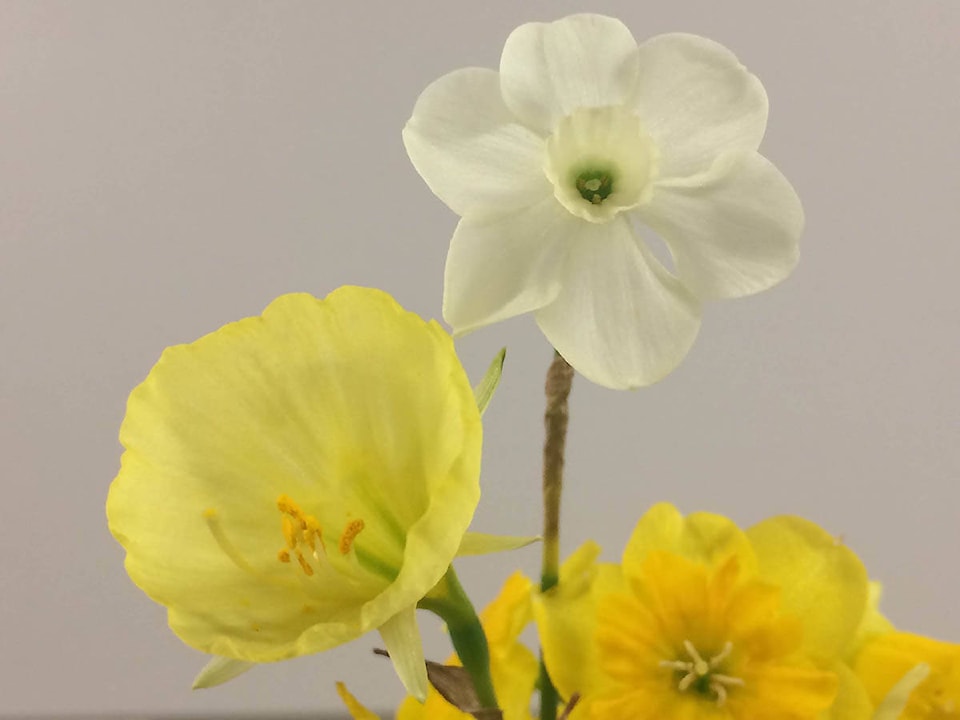When it comes to daffodils, it’s easy for the novice to fall into the trap of believing that bigger is better. That means trumpet daffodils, named for their generous snouts. They are the largest narcissus and not just in flower. When the bulbs arrive in early fall, they are burly enough to make you feel you’re getting a bargain, especially with a couple of daughter bulbs attached.
I saw a whole drift of King Alfred types (probably the ubiquitous Carlton) the other day in front of a country house hotel in Ireland. Along the entrance lawn by the hundreds, they had a pleasing presence and scale — their yellow brilliance was a match for the veil of drizzle. But as a cut flower in a table arrangement, they were a bit frightening. I looked away and asked for the cheese board.
It took me a long time to fully understand the delight of small daffodils but now wouldn’t be without them, either in autumn planting season or in April, payoff time.
Everything about them is delicate and refined, from their button-like cups to their grasslike leaves. Many are intensely fragrant. What they lack in bloom size, they can make up in the sheer number of flowers.
Brent Heath, the daffodil deity from Gloucester, Virginia, says one of his new hybrids, Sunlight Sensation, has as many as five stems per bulb, each with four or five blooms. A dozen bulbs might give you 300 flowers. “It has a lovely fruit-like fragrance,” he said.
Even long-established varieties combine delicacy with abundance. Minnow, white with yellow cups, has been around since the 1960s and still deserves to be in every garden. Hawera, developed in New Zealand way back in 1928, remains to me the most elegant of small daffodils, pale canary yellow with half a dozen or more blooms a stem.
An old yellow miniature named Tete-a-Tete has become the most common bulb used for forcing in pots.
Young people may not be well represented in the ranks of daffodil fanciers, but small daffodils offer a cheap and practical way for urban millennials to luxuriate in the genus Narcissus, named after that handsome but lonely dude who couldn’t get enough of himself. You can find many small daffodils for 50 cents to $1 a bulb (though rare, show-quality varieties can cost 100 times as much). The bulbs are usually ordered in early fall for autumn planting, though some mail-order nurseries offer discounts for early orders.
Miniature daffodils require little real estate and excel in pots and containers. The bulbs need winter’s chill — clay pots are fine in an unheated building, but those that stay outdoors should be of some frost-proof material.
They need a sunny location and excellent drainage, both more easily achieved in containers than in the ground. If you use them in garden beds, they are so obliging. Their lingering post-blooming foliage isn’t as intrusive as larger daffodils, so they can poke up in the spring through burgeoning hostas, creeping phlox, thyme — any sort of sympathetic ground cover — and never look untidy come May.
Washington Daffodil Society President Karen Cogar gave me a tour of her suburban garden that has one corner devoted to “minis.”
In an area of only six by eight feet, she was growing approximately 200 varieties of miniature daffodils. The term applies to those that grow under six inches and are on an ordained American Daffodil Society list, but many exquisite, small (if taller) daffodils are found outside those boundaries as well. Most varieties of triandrus, jonquilla and cyclamineus daffodils fit the bill.
Cogar collected 20 or so varieties of minis to show me. It was hard to pick a favourite. Angel’s Breath had three descending blooms on its single stem, all a soft lemon yellow and about 1 1/2 inches across. Even after a few days in a vase, the fragrance was strong and spicy. Mitzy is a white-flowering cyclamineus type with its petals swept back against an unusually long and slender corona.
You don’t have to have a balcony of pots for these smaller daffodils. Kogar led me through her woodland garden, where Minnow and Pacific Coast were flowering with hellebores and Virginia bluebells. Closer in appearance to species daffodils, they look at home in a woodland garden. Find a spot on the edge of the woods — they need sunlight to regenerate — and plant as many as you can. Heath, co-founder of Brent and Becky’s Bulbs, suggests you plant at least 10 bulbs for an effect. “Ten makes a nice big clump, eight to 12 inches in diameter,” he said.
I asked Heath to recommend three of his varieties for novices. He suggested Baby Boomer, a dwarf jonquil with loads of flowers and fragrance, and clusters of buttery yellow blooms; Tiny Bubbles, a short, nodding golden bloomer with petals that are swept back a little; and Snow Baby, a miniature trumpet growing to 10 inches with creamy white cups. I asked about powerfully fragrant varieties, and in addition to Baby Boomer, he recommended Baby Moon, a canary yellow jonquilla, and a variety named Canaliculatus, which is similar to Minnow but with more flowers and cups a stronger yellow.
Cogar travels to shows across the eastern United States at this time of year — they start in the South and move northward with the growing season — and is heartened when she sees younger people growing and showing. “Now if we could get Taylor Swift to grow daffodils, the whole world would grow them,” she said. Meanwhile, think small.
Adrian Higgins/By The Washington Post
